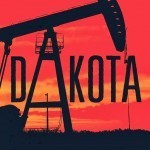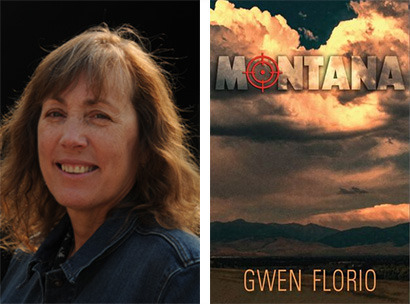Q&A: Gwen Florio
Newspaper people exist in a small world, which is how I felt as though I knew Gwen Florio even before I met her. We spent a number of years working for the same newspaper company. She was at the Missoulian, I was 350-some miles east at The Billings Gazette. She was a reporter. I spent most of my time on the copy desk, and editing her stories was how I grew familiar with her and her writing. When she chucked the newspaper career and became a full-time novelist, I can’t say I was surprised. I was doing the same thing.
Her first novel, MONTANA, let readers get to know Lola Wicks, a seasoned foreign correspondent who has been pulled back to the States against her wishes. Told to take some time off, she heads to Montana and lands in the middle of a murder mystery that is very personal to her.
Next up is DAKOTA, which puts Wicks back in the cross-hairs, this time in the booming Bakken oil formation. The new book releases March 21 from The Permanent Press.
In the midst of an active touring schedule, Florio was kind enough to answer a few questions …
 Q: DAKOTA comes on the heels of MONTANA, a novel that has garnered fine reviews and introduced us to journalist Lola Wicks. What do you want people to know going into this one?
Q: DAKOTA comes on the heels of MONTANA, a novel that has garnered fine reviews and introduced us to journalist Lola Wicks. What do you want people to know going into this one?
That Lola is back, and as bullheaded as ever. When she gets her teeth into a story, she can’t let go, even when specifically warned away. It takes place amid the social upheaval of North Dakota’s Bakken oil fields, a situation I found absolutely fascinating.
Your protagonist is a female journalist. You, of course, were a longtime, award-winning newspaper reporter. The inevitable question: How much of Lola is you?
One of the great pleasures about writing fiction is that you can create a protagonist who shares some of your own characteristics, and then make her so much better! For instance, I was never a full-time foreign correspondent. I just “parachuted” into situations for a few weeks and then came home. Lola is the seasoned correspondent I wish I’d been. As I’ve often remarked, she’s also taller, thinner and younger, which annoys the heck out of me. Sometimes I think that’s why I put her in such awful situations.
Why do you think so many reporters make the successful transition to fiction? And what caused you to think, OK, it’s time for me to leave the beat behind and focus my energy on books?
Because they got tired of a regular paycheck and health benefits? Seriously, most reporters I know are avid fiction readers, so it makes sense that they’d like to write novels. And, because they write daily, the prospect of writing a novel is probably not as daunting to reporters as to other people. Finally, that crack about a paycheck and health insurance actually was part of the impetus to finally give fiction a full-time go: As the field of journalism became more and more tenuous, with near-daily reports of layoffs and other cost-cutting measures at newspapers, it seemed silly to hang on to a job I felt as though I inevitably were going to lose, anyway. I also waited until I had a two-book contract before I left, so the leap wasn’t completely quixotic.
You’ve been traveling a lot and meeting readers in support of your first book. What has been the best moment you’ve experienced? Did anything surprise you?
A couple of things: Traveling around Montana, something the day job left little time for. Giving readings and doing research is a great way to see the state. Last summer, we drove out to the Bakken for research on DAKOTA, and then back along the whole Hi-Line, something I’ve wanted to do ever since I moved to Montana. It was worth the wait. Even more, it’s been great to connect with people who love books, and with other writers. I’ve met people, like you, whose work I’ve admired from afar. That’s much fun. The biggest surprise? The fact that readings in the smallest towns sometimes attract the biggest and most engaged audiences. That makes it doubly fun for me, because the smaller towns are the places I most enjoy going.
What led you to writing as a career?
I’ve always loved to read. I grew up in a very rural area without a lot of other kids around, so I just read and read and read. I was an English major in college (more reading) and got into journalism when my dad not-so-subtly suggested that I might need to channel all of that reading and writing into a job.
OK, you’re at home, working on a manuscript. What does a day of work look like?
I’m at my laptop no later than 9 a.m., a big change from when I used to slide into work a minimum of 10 minutes late each day (we won’t talk about all the unpaid overtime each night). When I had the day job, I shot for 500 words a day. When I first started writing full time, I upped that to 1,000, and recently started working on 1,500 to 2,000 a day. A daily total is important to me—it harkens back to my daily journalism deadline, so feels familiar, and it also helps me get through the hell of a first draft. Afternoons are for blogging (not often enough), setting up readings, and keeping track of the surprising amount of minutiae that goes along with this business. One more thing: I have a rule about not writing in my jammies. I have to be showered and dressed, more or less presentably, before I start work. Finally, when I’m deep into revisions, I often work well into the night. I’m not much fun to be around then.
How do you hone a project? Do you have a critique group or trusted early readers?
I’ve been a member of two terrific writing groups (Rittenhouse Writers’ Group in Philadelphia and 406 Writers in Missoula) over the years, and they’re really helpful, especially with short stories. Novels are a different animal, and I’m still feeling my way with them. On the advice of my agent, I hired an outside editor for MONTANA (Judy Sternlight; can’t say enough good things about her) and turned to her again for DAKOTA, and hope to do so with subsequent novels. I’m also a member of an online group of four women formed after last year’s Rocky Mountain Fiction Writers convention in Denver. That’s really helpful.
What lies beyond DAKOTA? Can you give us a glimpse into your next project?
WYOMING! And then, ARIZONA and UTAH. Seriously, my publisher did me a favor when he named the book MONTANA by giving me a theme of sorts. As long as people, please God, are interested in following Lola around, I’m going to keep sending her from one state to the next. It’s fun trying to figure out a plot that’s thematic to each place.
If you’re not writing, what interests fill your time?
For many, many years, writing took up all my spare time. I’m still getting used to the fact that I actually have personal time on evenings and weekends now. For starters, I’ve gotten reacquainted with my sweetie, a huge benefit. He comes along on my book research trips, so we’ve had fun exploring remote parts of North Dakota and Wyoming. I started running a couple of years ago, completing one marathon and three half-marathons so far. If my knee cooperates, I’ll shoot for at least one half-marathon this year. The training gets me outdoors on trails around Missoula, something that—even in the worst of weather—I just love. And, I can’t spend too much time in Glacier. Oh, and reading. Lots of reading. Never enough time for that.




